According to our new plans, Inoreader Pro is required to export RSS feeds.
If you are the owner of the feed, please consider upgrading to Pro.
According to our new plans, Inoreader Pro is required to export RSS feeds.
If you are the owner of the feed, please consider upgrading to Pro.

https://www.imaging-resource.com/news/2019/02/13/olympus-announces-12-200mm-super-telephoto-zoom
Using cheap gear for a photo shoot doesn’t mean you’ll end up with cheap quality images. You may have some limitations but the end result depends on your skill and how you make use of the tools at your disposal. Photographer Francisco Joel Hernandez demonstrates how you can take great images on a budget using off-camera flash (OCF):
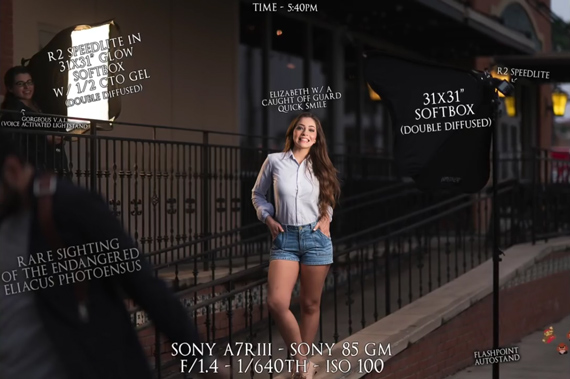
As Franciso demonstrates in the video, you can either use a single light source or use one light as a key light and another light source as a kicker light to add highlights on edges and hair. If you feel the need, you can also add in a reflector to bounce some light onto the model and fill shadows and even use a gel on the diffuser to add a creative touch.
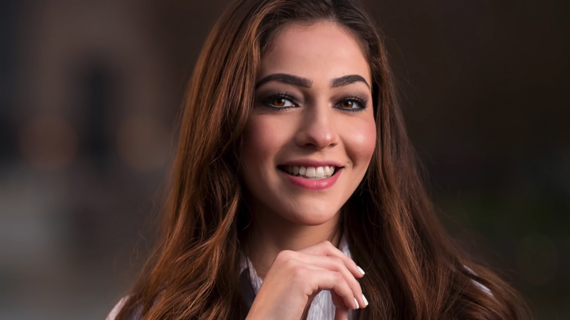
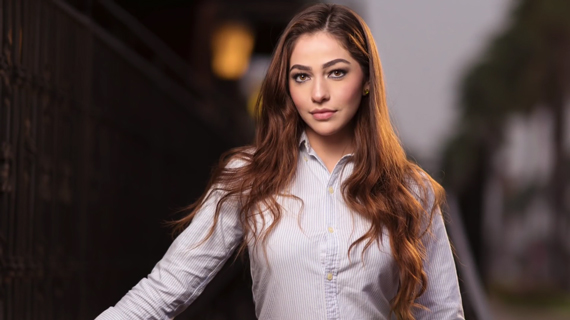

These images clearly exemplify that you don’t need high-end equipment for off-camera flash photography. If you’re just starting out with flash photography, this kind of setup is a great starting point.
For further training: The Electronic Flash Photography Guide at 52% Off
Go to full article: Off-Camera Flash Photography on a Budget
What are your thoughts on this article? Join the discussion on Facebook
PictureCorrect subscribers can also learn more today with our #1 bestseller: The Photography Tutorial eBook
The post Off-Camera Flash Photography on a Budget appeared first on PictureCorrect.
https://www.picturecorrect.com/tips/off-camera-flash-photography-on-a-budget/
There are several factors to consider when it comes to choosing paper for printing. Mike Crawford explains all you need to knowThere are several factors to consider when it comes to choosing paper for printing. Mike Crawford explains all you need to know
Lawrenceville, New Jersey, USA, February 11, 2019 – Datacolor®, a global leader in color management solutions, has launched SpyderX, its fastest, most accurate and easiest to Read more...

Android’s openness is something of a double-edged sword. On the one hand, it allows just about anybody to (relatively) easily write and publish mobile apps through the Play Store. But it also allows anybody to write and publish apps through the play store. And the checks to get apps approved aren’t quite as stringent as […]
The post Google pulled 29 photo apps from the Play Store that stole photos and promoted scams appeared first on DIY Photography.
http://erickimphotography.com/blog/2019/02/05/how-to-increase-your-self-confidence/
 |
A surprising report has revealed that Kodak Alaris, specifically its film unit responsible for bringing back Ektachrome 35mm film products, is up for sale. The business move was revealed by Inside Imaging, which reports that at least part of Kodak Alaris may be split off and sold as soon as next month.
Though the company had not publicly revealed its plans, some details emerged from a recently discovered financial report lodged with the UK's Companies House in December 2018. According to the report, which covers a time period of January 1 to March 31, 2017, Kodak Alaris' Paper, Photochemicals and Film (PPF) unit has been up for sale since January 2018 following the board's decision to 'actively divest the business to a buyer with greater market synergies.'
The report indicates the unit has a conservatively estimated value of $34 million and that 'advanced discussions with a bidder' for the PPF unit are currently underway. Kodak Alaris, at least based on the financial report, anticipates the sale will happen by March 31, 2019, but with the potential for spilling over to a later date.
Kodak Alaris' sole shareholder is the Kodak Pension Plan, a UK pension fund referred to as KPP2 that acquired Kodak Alaris from Eastman Kodak for $325 million in 2013. With Kodak Alaris came £1.5 billion / $2.7b in debt, and though Kodak Alaris is a profitable business, its bottom line after taxes has seen huge losses.
Kodak Alaris CEO Marc Jourlait confirmed to Inside Imaging that the company has 'privately briefed' potential customers on its intention to 'explore sale of some or all of our assets.' The PPF unit is already 'at an advanced stage of negotiations with a potential buyers [sic].'
https://www.dpreview.com/news/3179427253/kodak-alaris-is-looking-to-sell-off-its-paper-and-film-unit
 |
Photo chemistry manufacturer and supplier Tetenal Europe GmbH is reportedly set to close up shop after a prolonged search for new investors failed to secure its future. Under voluntary insolvency protection since last October, the German-based firm is set to complete its current production run and close its doors at the end of the financial year on April 1st, according to a report on the German imaging + foto contact website.
The closure could have serious consequences for the film processing industry as Tetenal manufactures chemicals under its own name as well as for many third party brands across Europe. It is also the main supplier of materials for the Kodak Express chain across the continent and the only supplier of consumables and service for Konica Minolta minilabs. It is also the distributor of Kodak Aerial Imaging Films and Chemicals in Europe, Africa and the Middle East.
 |
The company can trace its roots back to 1847 when drug wholesaler Theodor Teichgraber started distributing chemicals for wet collodion plates. Since then it has moved into the production of film chemistry for professional, high street and home users. It also has branched in to other chemical areas, such as agriculture, but has also become an important distributor for Epson, Eizo, Kodak and a range of inkjet and dye sub media.
The company had a change of management in April 2017 when Matthias Hübener stepped down from the day-to-day running of the firm for make way for Daniel Middendorf, who was still MD until this month. Hübener, who remains the business’ main shareholder, managed Tetenal for 24 years from 1993, taking over from his father Fritz who had become CEO and the main shareholder in 1960.
It isn’t clear at this stage how the closure of the Europe HQ will impact subsidiary companies in France, Poland and the UK. For more information see the Tetenal Europe GmbH website.
If you’ve ever had lens flare ruin a seemingly perfect shot, this extremely simple technique will save you a ton of headache in post-processing.
[ Read More ]
At the start of 2018, Neil Burnell set out to win Amateur Photographer of the Year (APOY). By Christmas, he’d done it. He tells Ailsa McWhinnie how he went about tackling the eight-round competitionAt the start of 2018, Neil Burnell set out to win APOY. By Christmas, he’d done it. He tells Ailsa Mc
http://erickimphotography.com/blog/2019/01/22/10-tips-how-to-shoot-more-interesting-photos/
5 Must-Know Photoshop Tips and Tricks for Photographers
In this article, I’m going to show you five of my favorite Photoshop tips and tricks for Photographers. These are techniques that most people probably don’t know, but are very useful and they can help you speed up your workflow.
#1 – OPEN THE SAME IMAGE IN TWO WINDOWS
In Photoshop, you can open the same image in two windows and set them side-by-side to work on both details and the overall image at the same time.
To open the same document in two windows, go to Window > Arrange, “New Window for [Name of Document].”
These are not two separate documents. They are the same document, and any adjustments that you make to one will reflect instantly on the other.
Then go to Window > Arrange > Two up Vertical to put the two tabs side-by-side. You can then Zoom into one window and zoom out on the other.
If you have two monitors, then you can place a zoomed in version in one monitor and a zoomed-out version on the other.
This technique comes in very handy when working with large documents. I once worked on a huge composite that had over 1,500 layers. By using this technique I saved a lot of time by not having to zoom in and out of an image after I made a small adjustment to details.
# 2 – NUDGE, SCALE, AND ROTATE CLONE TOOL SOURCE
To speed up your workflow when using the Clone Stamp Tool, remember that you can use keyboard shortcuts to nudge, scale, or rotate the sample source to better match the size and orientation of the cloning destination.
First, set the sample point by holding Opt/Alt and clicking on an area to sample from. You will then see an overlay of your sample source.
You can then try these keyboard shortcuts to adjust the sample source.
To nudge the Clone Source, you can hold Opt/Alt and tap on the Arrow keys (left, right, up and down).
To rotate the Clone Source Hold Alt (Mac: Option) Shift < or >.
To scale the Clone Source Hold Alt (Mac: Option) Shift or .
If you cannot remember these keyboard shortcuts, you could instead use the Clone Source panel (Window > Clone Source) to make these adjustments to the sample source.
#3 – SPOT HEALING BRUSH TOOL MODES
One way to quickly remove wrinkles, blemishes, and other distractions from portraits is to use the Spot Healing Brush Tool. But an often-overlooked option is the Modes dropdown which add a lot more power to this tool.
Under the Options bar, the Spot Healing Brush Tool has Blending Modes that you can use as you paint to better target the pixels that you want to remove.
To select the right mode, you first must look at the blemish, wrinkle, or distraction that you want to remove. Then ask yourself, is the distraction darker than the skin tone or is it lighter than the skin tone?
In the example for this article, the blemishes are darker than the skin tone. That means that you want to “lighten” those blemishes to reduce their intensity.
From the Modes dropdown select Lighten.
Then start painting with a small brush and small strokes over the blemishes and wrinkles to remove them. But notice how you will not lose essential detail in the highlights. The Spot Healing Brush Tool will only target dark pixels which are the pixels that you want to remove.
In the example below, you will see how the fine white hairs remained on the side of his head while the darker blemishes were removed.
If your blemish or distraction is lighter than the skin tone, then select Darken from the Mode drop-down menu, and paint away.
To learn more about how this technique works, you can check out my full-length tutorial on the Spot Healing Brush Tool.
#3 – LOAD LUMINOSITY AS A SELECTION
In Photoshop you can use the luminosity of an image (the bright pixels) as selections. The easiest way to select the bright pixels of a photo is by pressing Cmd Opt 2/Ctrl Alt 2.
If you cannot remember the keyboard shortcut, you can also load luminosity as a selection by holding Cmd/Ctrl and clicking on the RGB thumbnail in the Channels panel.
With a selection active, you can create an Adjustment which will target the bright pixels.
If you would like to target the dark pixels instead, you can “Invert” the selection. To do so, Select the Layer Mask, and click on Invert in the Properties panel. Alternatively, you can press Cmd I, Ctrl I when the layer mask is selected to Invert.
Now if you make an adjustment, the dark pixels will be affected instead of the bright ones.
#5 – CURVES AUTO COLOR CORRECTION
Did you know that you can color correct a photo with just one click?
With the Auto Color Correction Algorithms inside of the Curves (and Levels) Adjustment Layer, you can automate color correction in Photoshop.
This essential technique will let Photoshop do all the hard work, and it will automatically adjust each channel to color correct the image.
You can apply the Auto Tone non-destructively by creating a Levels or Curves adjustment layer, then click the “Auto” button in the Properties panel.
But the default algorithm is not usually the best one. To change the algorithm hold Opt/Alt and click on the Auto button.
Then, from the Auto Color Correction options you can select one of 4 algorithms to color correct your image. In Photoshop CS6 and newer, the default algorithm is Enhance Brightness & Contrast. In older versions of Photoshop, the default is Enhance Per Channel Contrast.
You can then click on the different algorithms and see how they affect your image. In most cases, I found that “Find Dark & Light Colors” give you the best results.
You can click on the “Save as defaults” checkbox so that this algorithm is applied when you click on the Auto button.
After you apply the color adjustment, you will see how the image will instantly be color corrected.
For more information on how this technique works and what to do when the auto color correction doesn’t work, you can check out my YouTube video on The Curves Auto Color Correction Options.
I hope that you enjoyed these tips and that they help you out in your workflow. If you want to learn more Photoshop tips and tricks like this one, then check out my video 19 Amazing Photoshop Tips, Tricks, and Hacks (That You Probably DON’T Know).
You can see more tutorials from Jesús at PhotoshopTrainingChannel.com, and keep up with him on Behance, Facebook, Instagram, LinkedIn, Pinterest, Twitter, and YouTube.
The post Guest Blog: Jesús Ramirez of Photoshop Training Channel appeared first on Scott Kelby's Photoshop Insider.
https://scottkelby.com/guest-blog-jesus-ramirez-of-photoshop-training-channel/
Reviewing some photos from last year, some tips: 1. Dynamic hand gestures Hand gestures to make triangles and other interesting compositions. Note the negative space to the left, the same direction Cindy is looking: 2. Tilt your camera + have leading lines Shoot photos while walking, and
Get up close and personal for great shots... Our experts suggest getting creative with compositions and backdrops and keeping a close eye on the details while watching out for distractionsOur experts suggest getting creative with compositions and backdrops and keeping a close eye on the details
 |
Adorama has announced the availability of a new studio flash head from its own Flashpoint range. Designed for photographers who don’t want TTL control, the XPLOR 600 Pro HSS offers 600WS of power with wireless triggering.
With the standard reflector fitted the head has a guide number of 87m / 285ft @ ISO 100. Users can expect 360 full power bursts from a single charge of the head’s 2.6Ah lithium ion battery pack. An optional AC adapter is available, but even when powered by the battery recycle-times are between 0.01 and 0.9 seconds. The head uses a 2.4GHz wireless system making the XPLOR 600 Pro HHS compatible with the Godox X radio triggers, which are available for all the main camera brands.
 |
Wireless control works across 32 channels and x-compatible flashes can be separated into five groups. Two optical slave modes are offered, with all settings dealt with on the large side-mounted LCD panel. The HSS in the name refers to the head’s ability to sync with shutter speeds of up to 1/8000sec, and the output can be varied across 9 stops to 1/256th in 25 steps. A battery and charger are included in the kit, along with a standard reflector in the Bowens S mount.

The head is the non-TTL version of the XPLOR 600 Pro TTL, and is priced $749 against the $899 charged for the TTL model. It is also a version of the Godox AD600 Pro head that has TTL. For more information see the Adorama website.
BREAKING THE PLANE- 3D For Photographers
I was recently watching a tutorial on advanced product retouching in Photoshop, during which the instructor spent an astounding amount of time removing imperfections and isolating every element to its own layer. It was eye-opening, but not in the way I expected. During my career I’ve captured a client’s or art director’s vision on a two-dimensional plane with lighting, subject matter, resolution, and camera angle baked-in forever. This had me looking for another way to approach image and motion creation.
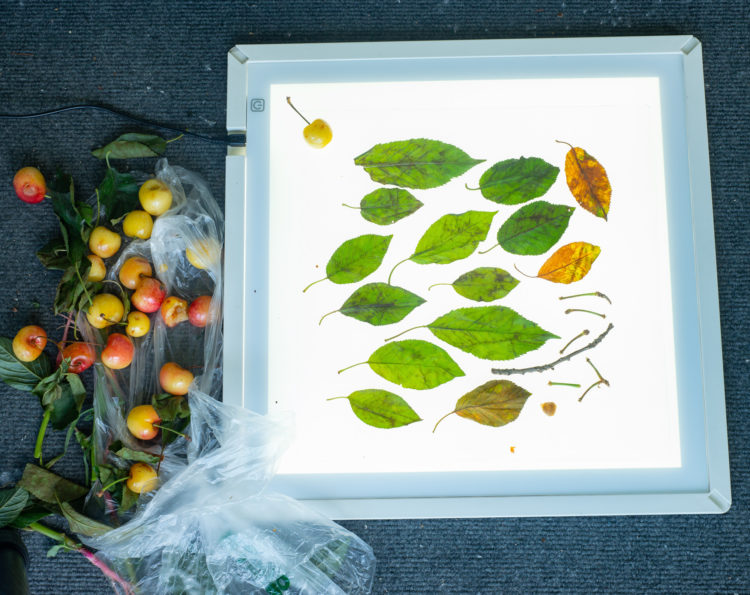 Here I’m on location capturing overhead shots of foliage to be used in SpeedTree to re-generate the plants in the 3D realm. I capture a naturally lit overhead shot as well as a back lit shot to tell the 3D program how the texture is to look when back-lit.
Here I’m on location capturing overhead shots of foliage to be used in SpeedTree to re-generate the plants in the 3D realm. I capture a naturally lit overhead shot as well as a back lit shot to tell the 3D program how the texture is to look when back-lit.During a recent series of trips to New York, I found myself with quite a bit of downtime in the evenings which allowed me to dive headfirst into the world of 3D. 3D is nothing new, but as of late the software and hardware is advancing at lightning speed, and I noticed that it wasn’t being used in generating food imagery nearly as much as it should.
In order to use 3D in production as a food photographer, I needed to become adept at modeling, texture creation, photogrammetry, VFX, compositing, and sculpting. Not an easy task and as many know, but the learning never ends!
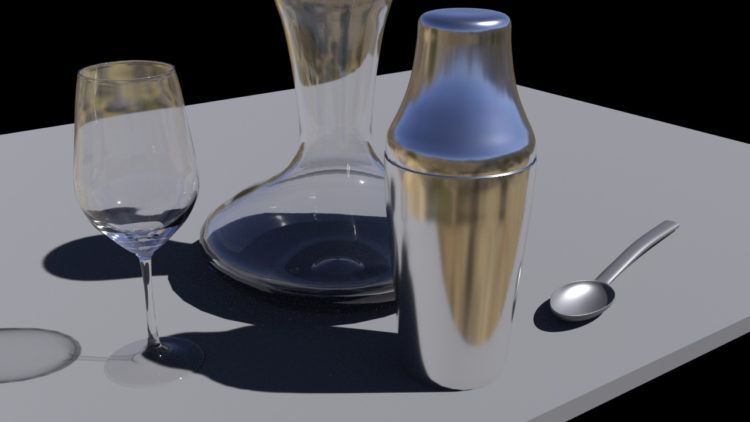 This entire scene was modeled, lit, and rendered in around 30 minutes. The scene still has that overly-slick 3D look so blending in grunge maps and other imperfections to the scene works wonders. This scene was lit with what’s known as an HDRI map with is essentially a spherical panorama of a location that is used as the lighting source.
This entire scene was modeled, lit, and rendered in around 30 minutes. The scene still has that overly-slick 3D look so blending in grunge maps and other imperfections to the scene works wonders. This scene was lit with what’s known as an HDRI map with is essentially a spherical panorama of a location that is used as the lighting source.My current software workflow includes Modo for hard surface modeling, Substance Designer and Substance Painter for texture authoring and painting, Zbrush for sculpting 3D meshes, Reality Capture for photogrammetry, SpeedTree for foliage generation, Marvelous Designer for fabric, Houdini for VFX, Redshift for rendering, and of course Photoshop for the final touches!
For organic objects, nothing beats photogrammetry! To create this oyster asset, I shot the oyster on a Lazy Susan from every angle possible and stitched the images together in Reality Capture. The resulting 3D mesh is then cleaned up in Zbrush and the color texture is cleaned up in Photoshop.
My favorite breakthrough in 3D and one that doesn’t get nearly enough focus in 3D software development is VR. I currently use MODO for modeling, and they recently implemented a VR viewport allowing the user to physically enter the 3D space. This is important as I’m used to moving around a physical subject and my hope is eventually to be able to conduct a virtual photo shoot live within this realm.
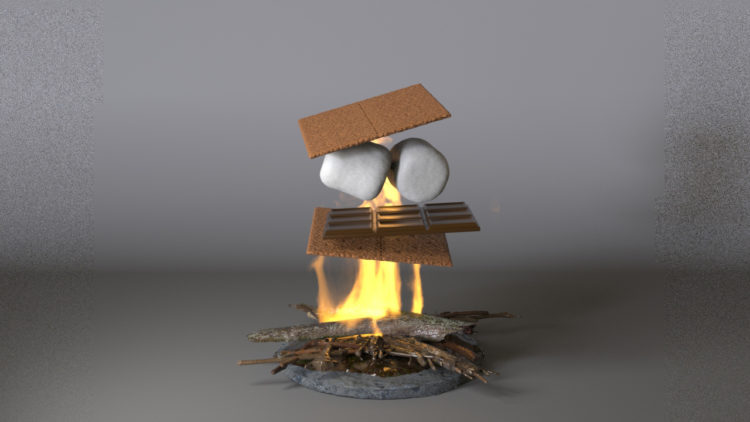 What I love about 3D is that anything becomes possible and the food on set never goes bad!
What I love about 3D is that anything becomes possible and the food on set never goes bad!The strength of 3D lies in the ability to create any photorealistic environment you want and change anything from lighting to export resolution forever. Learning 3D also makes you a better photographer. Photographers always tout their understanding of light, but it took me all of two minutes learning PBR material authoring to realize I didn’t know squat!
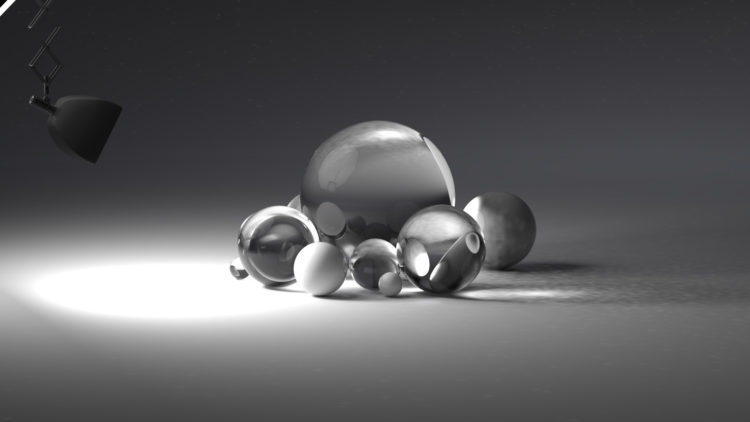 Rendering realistic objects is challenging and render times increase as the light complexity increases. I will often test techniques in isolation such as caustics and light bounce counts.
Rendering realistic objects is challenging and render times increase as the light complexity increases. I will often test techniques in isolation such as caustics and light bounce counts.I use Redshift for nearly all of my rendering needs and I tend to render out EXR files which contain the various “passes” needed for post-production. This process separates depth, luminance, puzzle matte, roughness, albedo, emission, sub-surface scattering, and other passes so that each element can be manipulated separately in Photoshop or After Effects If the export is for motion.
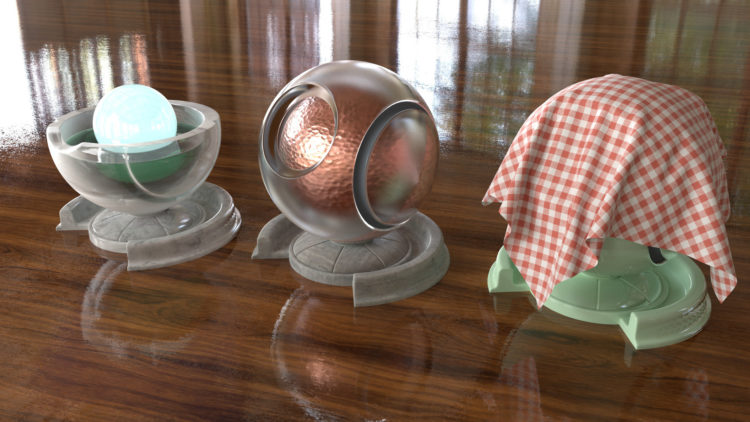 Material authoring is addictive but time-consuming. There are many 3rd party sources that provide a variety of base materials such as these to get your started.
Material authoring is addictive but time-consuming. There are many 3rd party sources that provide a variety of base materials such as these to get your started.As much flexibility as 3D offers, every still image render ends up in Photoshop where the final creative touches are applied. Having a strong knowledge of Photoshop, lighting, camera operation, etc. gives photographers a strong starting point to learn 3D.
The more I progress in adding 3D to my wheelhouse, the more I realize that this hybrid approach to image creation will soon be a requirement for emerging photographers.
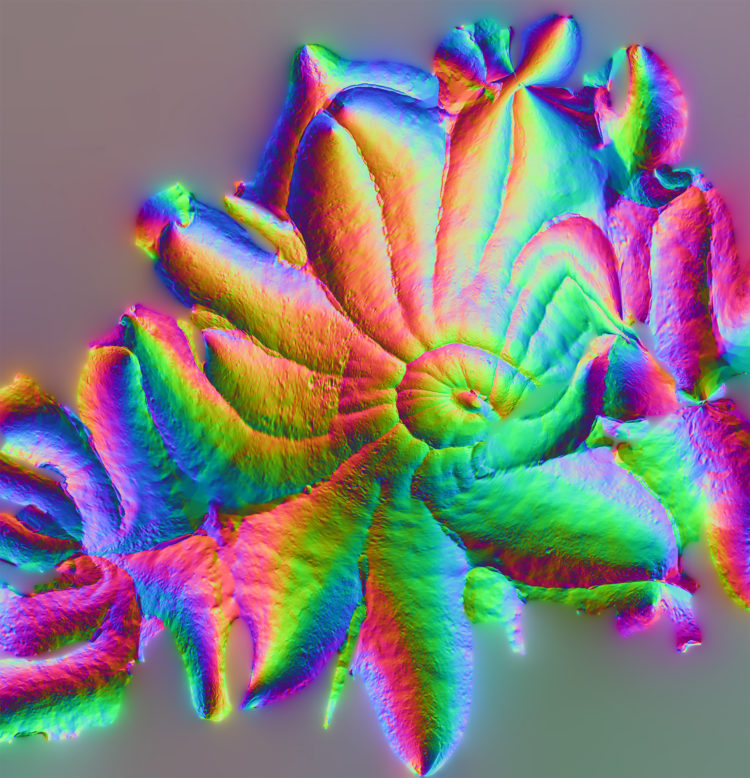 Every material applied to objects is a series of tiles, typically 4-8k square in resolution. To apply a texture to an object, it often needs to be “flattened” by creating a UV map. This bizarre image is a world space normal of a UV flattened Buddah’s Hand Fruit.
Every material applied to objects is a series of tiles, typically 4-8k square in resolution. To apply a texture to an object, it often needs to be “flattened” by creating a UV map. This bizarre image is a world space normal of a UV flattened Buddah’s Hand Fruit.There’s an enormous amount of information to take in when learning 3D, but hopefully this will help you know where to begin when adding 3D to your image creation wheelhouse.
MODO VR:
You can see more of Steve’s work at SteveHansenImages.com, and keep up with him on Instagram.
The post Guest Blog: Food Photographer and 3D Artist Steve Hansen appeared first on Scott Kelby's Photoshop Insider.
https://scottkelby.com/guest-blog-food-photographer-and-3d-artist-steve-hansen/